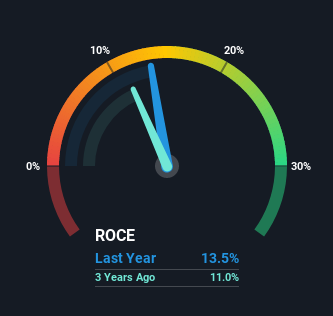Returns On Capital Are Showing Encouraging Signs At V.S. Industry Berhad (KLSE:VS)

If you're not sure where to start when looking for the next multi-bagger, there are a few key trends you should keep an eye out for. Typically, we'll want to notice a trend of growing return on capital employed (ROCE) and alongside that, an expanding base of capital employed. Put simply, these types of businesses are compounding machines, meaning they are continually reinvesting their earnings at ever-higher rates of return. Speaking of which, we noticed some great changes in V.S. Industry Berhad's (KLSE:VS) returns on capital, so let's have a look.
What is Return On Capital Employed (ROCE)?
Just to clarify if you're unsure, ROCE is a metric for evaluating how much pre-tax income (in percentage terms) a company earns on the capital invested in its business. To calculate this metric for V.S. Industry Berhad, this is the formula:
Return on Capital Employed = Earnings Before Interest and Tax (EBIT) ÷ (Total Assets - Current Liabilities)
0.13 = RM329m ÷ (RM3.5b - RM1.1b) (Based on the trailing twelve months to October 2021).
So, V.S. Industry Berhad has an ROCE of 13%. In absolute terms, that's a pretty normal return, and it's somewhat close to the Electronic industry average of 14%.
Check out our latest analysis for V.S. Industry Berhad

Above you can see how the current ROCE for V.S. Industry Berhad compares to its prior returns on capital, but there's only so much you can tell from the past. If you'd like to see what analysts are forecasting going forward, you should check out our free report for V.S. Industry Berhad.
So How Is V.S. Industry Berhad's ROCE Trending?
The trends we've noticed at V.S. Industry Berhad are quite reassuring. Over the last five years, returns on capital employed have risen substantially to 13%. The amount of capital employed has increased too, by 93%. This can indicate that there's plenty of opportunities to invest capital internally and at ever higher rates, a combination that's common among multi-baggers.
One more thing to note, V.S. Industry Berhad has decreased current liabilities to 31% of total assets over this period, which effectively reduces the amount of funding from suppliers or short-term creditors. So this improvement in ROCE has come from the business' underlying economics, which is great to see.
Our Take On V.S. Industry Berhad's ROCE
In summary, it's great to see that V.S. Industry Berhad can compound returns by consistently reinvesting capital at increasing rates of return, because these are some of the key ingredients of those highly sought after multi-baggers. And with a respectable 63% awarded to those who held the stock over the last five years, you could argue that these developments are starting to get the attention they deserve. With that being said, we still think the promising fundamentals mean the company deserves some further due diligence.
Since virtually every company faces some risks, it's worth knowing what they are, and we've spotted 3 warning signs for V.S. Industry Berhad (of which 1 is a bit concerning!) that you should know about.
While V.S. Industry Berhad may not currently earn the highest returns, we've compiled a list of companies that currently earn more than 25% return on equity. Check out this free list here.
New: Manage All Your Stock Portfolios in One Place
We've created the ultimate portfolio companion for stock investors, and it's free.
• Connect an unlimited number of Portfolios and see your total in one currency
• Be alerted to new Warning Signs or Risks via email or mobile
• Track the Fair Value of your stocks
Have feedback on this article? Concerned about the content? Get in touch with us directly. Alternatively, email editorial-team (at) simplywallst.com.
This article by Simply Wall St is general in nature. We provide commentary based on historical data and analyst forecasts only using an unbiased methodology and our articles are not intended to be financial advice. It does not constitute a recommendation to buy or sell any stock, and does not take account of your objectives, or your financial situation. We aim to bring you long-term focused analysis driven by fundamental data. Note that our analysis may not factor in the latest price-sensitive company announcements or qualitative material. Simply Wall St has no position in any stocks mentioned.
About KLSE:VS
V.S. Industry Berhad
An investment holding company, engages in the manufacturing, assembling and selling electronic and electrical products, and plastic molded components and parts.
Very undervalued with excellent balance sheet and pays a dividend.
Market Insights
Community Narratives



